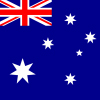INTELLECTUAL PROPERTY RIGHTS IN AUSTRALIA

Opposition Term |
02 Months |
Registration Term |
10 Years |
First Renewal Term |
10 Years |
Subsequent Renewal Term |
10 Years |
The Trade Marks Act 1995, in force since January 1, 1996 - is the primary law governing the mechanism of trademark registration and protection in Australia.
Australia is a member of the Madrid Protocol.
For seeking trademark protection in Australia, an application has to be filed with the Australian Government Agency (IP Australia), which administers the entire process of trademark registration.
Australia follows the 11th edition of Nice Classification. Multi-class trademark applications are acceptable; however, additional fees are payable if an application is to cover more than 1 class.
The third parties can file opposition actions against a trademark application within two (02) months following its publication date in the Australian Official Journal of Trade Marks.
In Australia, registered trademarks have a validity of ten (10) years from the date of application, which can be further renewed indefinitely for successive periods of ten (10) years each.
The grace period to renew a trademark after the date of expiry is six (06) months.
The period for cancellation of a registered trademark based on non-use is three (03) years from the date of registration.
Australia is a member of the Paris Convention for the Protection of Industrial Property and the Patent Cooperation Treaty (PCT).
The Commonwealth Patents Act (1990) and the attendant Patents Regulations (1991) deal with the mechanism of patent protection in Australia.
For seeking patent protection in Australia, an application has to be filed with the Patent Office of IP Australia, a Federal Government organization.
In Australia, two types of patents can be protected, namely standard patents and innovation patents.
The types of patent applications that can be filed include Non-Convention Application, Convention Application, PCT National Phase Application, Divisional Application, and Patent of Addition.
The time frame for PCT national phase filing is thirty-one (31) months.
In Australia, an opposition against a patent application can be raised both at the pre-grant and the post-grant stage. At the pre-grant stage, any third party may raise an opposition within three (03) months (after the patent gets published but before it is granted) approximately. At the post-grant stage, any third party may raise an opposition any time after the date of publication of the patent grant.
A standard patent lasts for twenty (20) years in Australia. The term of standard patents for certain pharmaceutical substances can be extended by up to five (05) years. An innovation patent has a term of eight (08) years.
The Designs Act 2003 governs and deals with the mechanism of registration of industrial designs in Australia.
The types of industrial design applications that can be filed in Australia include Non-Convention Application and Convention Application.
Utility model protection isn't provided under industrial design protection in the nation.
Opposition against an industrial design application can't be raised in the nation.
The total duration of industrial design registration in Australia is ten (10) years from the date of application. The initial registration term is five (05) years, which is further extendible for an additional term of five (05) years upon payment of the renewal fee.
The time frame for payment of the renewal fee before the due date is six (06) months.
There is a grace period of six (06) months to renew a registered industrial design.
Australia is a member of almost all the international conventions on copyright law, including the Berne Convention, Universal Copyright Convention (Paris), Universal Copyright Convention (Geneva), TRIPS Agreement, and WIPO Copyright Treaty.
The Copyright Act, 1968 and The Copyright Amendment Act, 2006 - form the basic legislation of copyright protection in Australia.
The standard copyright protection term lasts for the lifetime of the author plus seventy (70) years following his death. However, the duration of copyright protection varies depending on the type of work.
In the case of sound recordings and cinematograph films, the duration of copyright protection lasts seventy (70) years from publication.
In the case of television broadcasts and sound broadcasts, the duration of copyright protection lasts fifty (50) years from publication.
In the case of published editions of works, the duration of copyright protection lasts twenty-five (25) years from publication.

